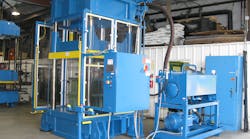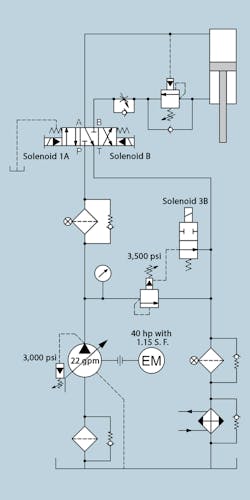A press that had worked well for several years wouldn’t start. The electric motor would hum and buzz for a few seconds, then cause the overloads to trip. Maintenance people figured the electric motor “ran out of juice,” as they said, so they replaced it with the same size and brand. They felt that a 40-hp motor with a 1.15 service factor should deliver 46 hp with no problem when they calculated the flow and pressure requirements. However, when the new motor was installed, it did the same thing, stalling out.
When the system was turned on, solenoid 3B would be energized after 3 sec. This is a common technique to reduce the high inrush current demand of ac electric motors. Mechanics confirmed that 3 sec. occurred before solenoid 3B energized. They discovered that if they lowered the pump’s compensator pressure to 2,500 psi, the motor could start the HPU. Once it did, they then reset the compensator back to 3,000 psi. It would run continuously until they shut the system down and they would have to go through the same routine to get it started again.
Any idea what was happening?
Find the Solution
Think you know the answer to this month’s problem? Submit your solution via e-mail. All correct answers submitted by March 22, 2018 will be entered into a random drawing for a $50 gift card. The winner will be notified, and his or her name will be printed in a future issue. Only one gift card will be awarded to any participant within a calendar year.
Solution to Last Month’s Challenge:
When a pressure-compensated pump circuit has a safety relief valve, the valve is normally set 200 to 300 psi higher than the compensation pressure. This will “clip” any pressure spikes caused by the directional valve shifting to the blocked center position faster than most pumps can react to. When the pump pressure was increased, the relief valve should’ve been increased by the same amount. Increasing the relief setting solved the overheating problem.



